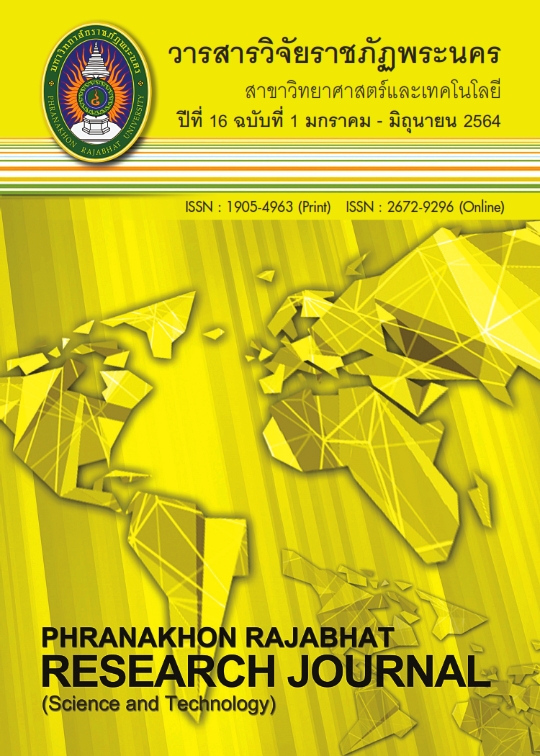EFFECTS OF COFFEE PEEL POWDER SUPPLEMENTION ON QUALITIES OF CAKE
Keywords:
Coffee Peel Powder, Cake, SupplementionAbstract
The objective of this research is to develop cake product by coffee peel powder, to examine customers’ acceptance, to explore chemical composition and physical properties by The cake with coffee peel powder was developed by adding 3 levels of coffee peel powder: 3, 6 and 9% of wheat flour weight. Then 9-Point Hedonic Scale Test was applied to determine the appearance, color, smell, flavor, texture and the overall acceptance ot the procuct. The result of sensory testing by 100 of partrcipants showed that the most acceptance was the cake with 3 % of coffee peel powder (p < 0.05). The chemical composition study indicated that the cake with 3 % of coffee peel powder consisted of moisture 20.16%, ash 0.98%, protein 7.02%, fat 20.27%, carbohydrate 51.57%, insoluble fiber 0.09 grams calories was 416.79 Kcal. and anti-oxidant activity of 31.11 micromole trolox per 100 grams. The physical quality test showed that cake L* a* b* color values were 52.96, 12.48 and 20.48, respectively.
References
A.O.A.C. (2016). Official Methods of Analysis. (17th ed.), Gaithersburg, Maryland: Association of Official
Chemists. Washingtom D.C.
Apipattarakul, S. (2016). Comparative Quantity of Caffeine, Phenolic Compound and Free Radical
Scavenging Activity in Coffee Grounds and Spent Coffee Grounds. Naresuan Research Conference, 12, 173-183. (in Thai)
Central Laboratory (Thailand) Co,. Ltd. (2017). Bangkok. [In Thai]
Chamber IV, E. & Wolf, M.B. (1996). Sensory tesing methods. (2nd ed). Philadelphia: USA. American
Society for Testing and Materials.USA.
Jammekh, J., & Naiwikul, O. (2014). Basic banking science and technology. Bangkok: Kasetsart
University. (in Thai)
Khngoan(2018). Enzymatic browning reaction. Retrieved from http: annachonnapatremember.
wordpress.com/. [2018, 5 January.]
Le, P. (2012). Cafe Sweets Passion. Bangkok: Pimdee. (in Thai)
Maeban. (2013). Basic bakery. Bangkok: Maeban. (in Thai)
Maeban. (2016). Bakery ovens menu. Bangkok: Maeban. (in Thai)
Office of Industrial Product Standard. (2015). Thai Community Product Standard Roasted Coffee, 268/2558. [In Thai]
Pellati, F., Benvenuti, S., Magro, L., Melegari, M. & Soragni, F.( 2004). Analysis of phenolic compounds and
radical scavenging activity of Echinacea spp. Journal of Pharmaceutical and Biomedical Analysis, 35(2), 289-301.
Phnichykul, J., Lilawachrmas, V., Phngsphrrnceriy, P., Phrrnnarunothay, R., Wimlkesm, N., & Suphkickaycna, V. (2007). Assorted knowledge about food for health and beauty Polyphenols: anti-oxidants. Jarpa Journal. Food & Health. The 15th International Processing, Filling and Packaging
Event for Asia: 13 -16 June 2007, Bangkok
Ploypradub, C., Cheamsuphakit, B., & Punbusayakul, N. (2010). Antioxidant Properties of Different
Parts of Arabica Coffee Berry and Spent Coffee Ground. AgriculturalSci. J,41(3/1), 577-580.
Ramirez-Martinez, J.R. (2006). Phenolic Compounds in Coffee Pulp: Quantitative Determination
by HPLC. Journal of the ScienceofFood and Agriculture, 43, 135-144.
Raungrusmee, S., Jadwong, K., & Wongtong,O. (2018). The development of sandwich bread recipes
by using rice bran rice berry instead of wheat flour. Phranakhon Rajabhat ResearchJournal, 13(1), 123-138. [In Thai]
Sajilata, MG., Singhal, R.S., & Kulkarni, R. (2006). Resistant Starch-A review. Comprehensive Reviews in Food Science and Food Safe,y 5, 1-17.
Spiller, G.A. (1998). Caffeine, CRC Press. USA, 377.
Shahidi, F., & Naczk, M. (2003). Food Phenolics: Sources, Chemistry, Effects, Applications. CRC Press, 576.
Downloads
Published
Issue
Section
License
โปรดกรอกเอกสารและลงนาม "หนังสือรับรองให้ตีพิมพ์บทความในวารสารวิจัยมหาวิทยาลัยราชภัฏพระนคร สาขาวิทยาศาสตร์และเทคโนโลยี" ก่อนการตีพิมพ์




